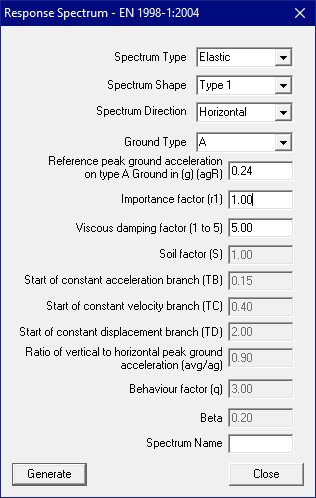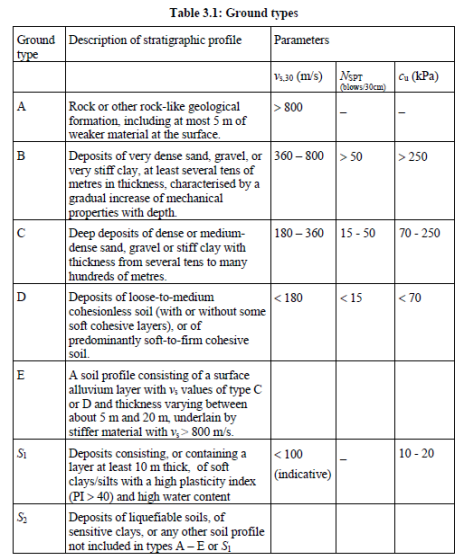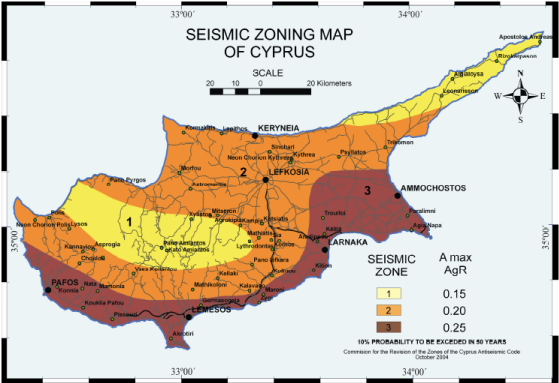Response Spectrum - EN 1998-1:2004
The guidelines for generating the Elastic Response Spectrum and Design Response Spectrum for both horizontal and vertical directions, as outlined in "EN 1998-1:2004" are provided below. For details on implementation, see the Section titled “Response Spectrum - EN 1998-1:2004” in CAEPIPE Code Compliance Manual.

Spectrum Type
Elastic Response Spectrum
Generates the elastic response spectrum (in terms of spectral acceleration), representing the seismic action in either the horizontal or vertical direction, in accordance with Section 3.2.2.2 of EN 1998-1:2004.
Design Response Spectrum
Generates the design response spectrum (in terms of spectral acceleration), representing the seismic action in either the horizontal or vertical direction, in accordance with Section 3.2.2.5 of EN 1998-1:2004.
This spectrum is applicable for the design of ductile structures where the inelastic behavior is taken into account explicitly with the behavior factor q.
Spectrum Shape
Type 1
Type 1 spectra correspond to typical high seismicity hazard.
Type 2
Low seismicity Type 2 spectra are recommended when the earthquakes that contribute most to the seismic hazard have a surface-wave magnitude, Ms, not greater than 5.5. For more details see EN1998-1:2004 Section 3.2.2.2(2)P and the National Annex.
Custom
Select custom to manually specify the parameters of the spectrum.
Spectrum Direction
Horizontal
Generates horizontal elastic response spectrum Se(T) as per Section 3.2.2.2 of EN 1998-1:2004.
Vertical
Generates vertical elastic response spectrum Se(T) as per Section 3.2.2.3 of EN 1998-1:2004.
Ground Type
The ground types A, B, C, D and E are defined by the stratigraphic profiles and parameters outlined in Table 3.1 of EN1998-1:2004, as shown below.

Select 'custom' shape type to manually specify the spectral parameters S, TB, TC, TD etc.
Reference peak ground acceleration
Reference peak ground acceleration on type A ground (rock).
For the purposes of EN 1998, National Authorities have divided national territories into seismic zones based on local hazard levels. By definition, the seismic hazard within each zone is considered to be uniform.
For most of the applications of EN 1998, the hazard is described in terms of a single parameter, i.e. the value of the reference peak ground acceleration on type A ground, agR.
The reference peak ground acceleration on type A ground, agR, for use in a country or parts of the country, may be derived from zonation maps found in its National Annex.
As an example, figure given below provides the value of agR for CYPRUS.

Links given below may be used to obtain the value of agR for different European countries.
Importance factor
An importance factor of γ = 1.0 corresponds to typical structures of average importance. Importance factors are given in the relevant Parts of EN1998-1:2004.
Viscous damping factor
Typically, a damping ratio of 5% is used for structures in the elastic range. For special cases, if a different viscous damping ratio is required, it is specified in the relevant part of EN1998-1:2004.
S, TB, TC, TD, avg, ag, q, Beta and Name
S is the soil factor.
TB is the lower limit of the period of the constant spectral acceleration branch.
TC is the upper limit of the period of the constant spectral acceleration branch.
TD is the value defining the beginning of the constant displacement response range of the spectrum.
The values of the periods TB, TC and TD and of the soil factor S describing the shape of the elastic response spectrum depend upon the ground type. For further details, refer to the Section titled “Response Spectrum – EN 1998-1:2004” in CAEPIPE Code Compliance manual.
ag is the design ground acceleration on type A ground and avg is the design ground acceleration in the vertical direction.
Recommended values of parameters avg/ag, TB, TC and TD describing the vertical elastic response spectra for Spectrum Type 1 and Type 2 are provided in Table 3.4 of EN 1998-1:2004
q is the behavior factor. Typically the value is 3.0 for horizontal component. For the vertical component of the seismic action a behavior factor q up to 1.5 should generally be adopted for all materials and structural systems.
Beta is the lower bound factor for the horizontal design spectrum.
Name is the name of the Spectrum up to 32 characters.